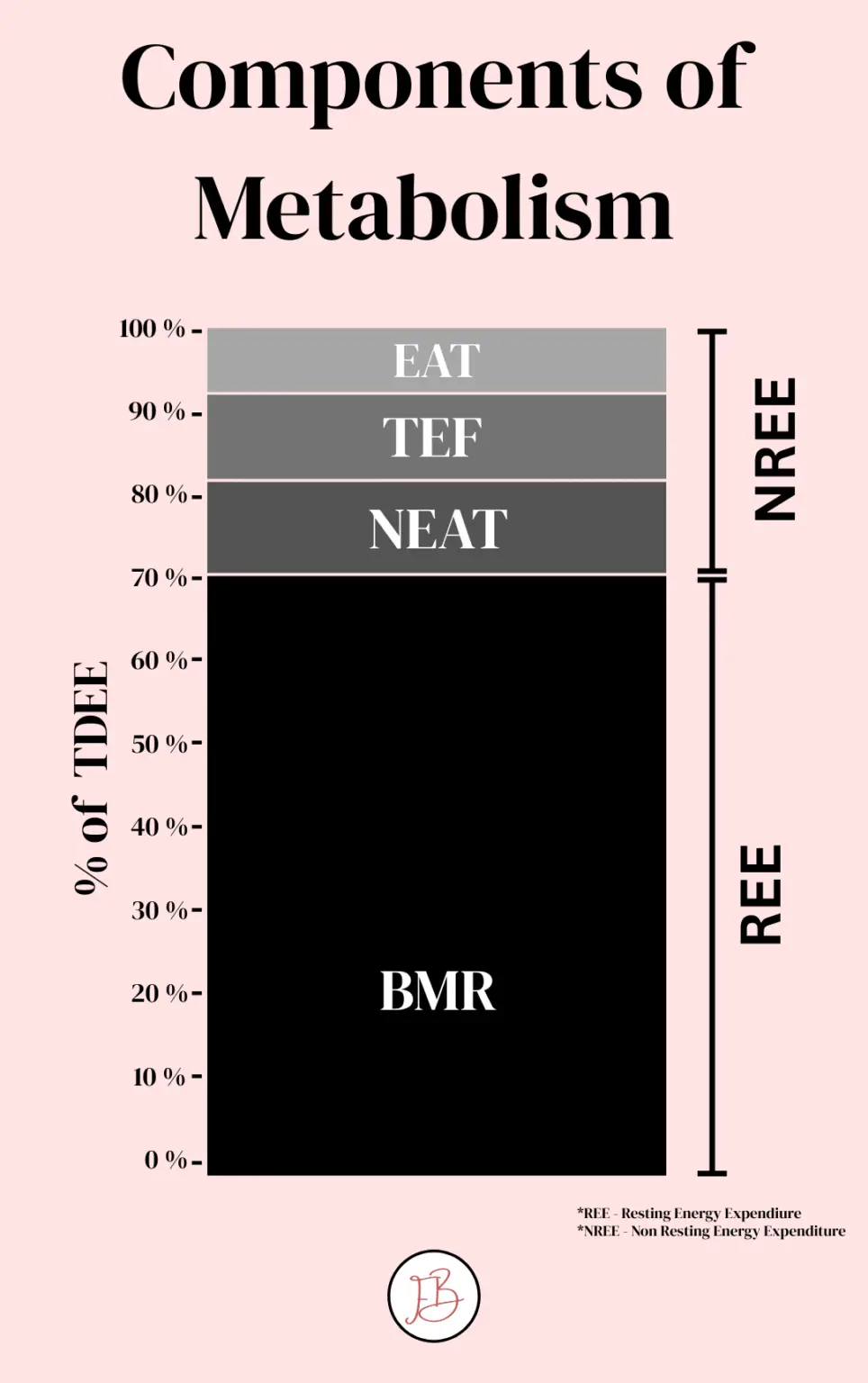Metabolism 101: How Do You Burn Calories?
Ever wonder why some people seem to eat whatever they want and never gain a pound, while others carefully watch their portions and still struggle with weight? The answer often comes down to one key factor: metabolism. Metabolism is what keeps you alive and functioning by converting the food you eat into energy.

Table of Contents
What Is Metabolism?
Metabolism is the set of chemical reactions that keep your body running (1). It’s how your body converts what you eat and drink into energy, and then uses that energy to power everything from breathing and circulation to thinking and moving. Sex, height, age, activity, nutrition, hormone health, and illness all have an impact on the body’s rate of energy generation, which is expressed in calories.
There are four main components of metabolism (2)(3):
- Basal Metabolic Rate (BMR)
- Thermic Effect of Food (TEF)
- Exercise Activity Thermogenesis (EAT)
- Non Exercise Activity Thermogenesis (NEAT)
TDEE = BMR + TEF + EAT + NEAT
Each metabolic component contributes to our total daily energy expenditure (TDEE) by using energy.

How does metabolism work?
Catabolism and anabolism are the two main chemical processes that make up metabolism. Anabolic processes utilize the energy generated by catabolic events to create bigger molecules, whereas catabolic reactions control the breakdown of food to provide energy (4). The maintenance of life depends on both anabolic and catabolic processes.
- Catabolism: The breakdown of molecules to provide energy is known as catabolism. In order to give the body energy and the fundamental building blocks needed for growth, macronutrients (proteins, carbs, and fats) are broken down into their simpler forms (5).
- Anabolism: Anabolism is the production of every substance that the cells need. This includes the processes of development and repair, which use the energy found in food (6).
A less percentage of the energy (calories) we consume each day is used to fuel activities, but the majority is needed to maintain catabolic and anabolic responses in the body.
The Science Behind Burning Calories
Your body works continuously to create energy, even while you’re at rest, so burning calories isn’t limited to the gym. Your metabolism, which converts the food you eat into fuel your body can utilize, is what drives this process.
- From Food to Fuel: Your body breaks down the macronutrients—fats, proteins, and carbohydrates—into smaller parts, such as fatty acids and glucose, when you consume. These enter your circulation and go to your cells, where they are transformed into adenosine triphosphate (ATP), the primary energy source for your body. Everything from lifting weights to blinking is supported by this energy.
However, micronutrients like vitamins and minerals are also important; eating isn’t simply about energy. They help your body’s enzymes and chemical processes, which are essential for effective metabolism. - The Role of Oxygen:
For metabolism, oxygen is essential. Through a process known as aerobic respiration, your cells use it to assist in converting foods into energy. Because your body requires more oxygen to fulfill the demand for ATP, physical exercise causes your breathing and heart rate to increase.
-
Thermic Effect of Food (TEF): Even digesting food burns calories. This is known as the Thermic Effect of Food, or TEF. It refers to the energy your body uses to chew, digest, absorb, and store nutrients. Among the macronutrients, protein has the highest TEF, requiring more energy to break down than carbs or fat.
-
Non-Exercise Activity Thermogenesis (NEAT): A process known as Non-Exercise Activity Thermogenesis (NEAT) helps people burn calories via everyday activities including walking, fidgeting, and even standing. It’s a frequently disregarded component of your overall metabolic rate, yet it may have a significant impact, particularly for those who lead busy lives.
-
Exercise and Metabolic Rate: Strength training and cardio are examples of structured physical activities that increase your metabolic rate during and after a workout. While weight training aids in the development of lean muscle, which eventually raises the resting metabolic rate, cardio helps burn calories instantly. This implies that even when you’re not exercising, you’ll burn more calories.
Factors That Affect Metabolism
These are the factors that influence the metabolism:
- Age and Muscle Mass: Your metabolic rate tends to decrease with age, partly because of a natural decrease in muscle mass. Strength training can assist maintain or increase lean muscle, which can help you offset the effect of fat burning more calories at rest than muscle (7).
- Genetics and Gender: Some people are naturally born with a faster or slower metabolism. Your genes plays a vital role in how efficiently your body processes food and burns calories. Additionally, men typically have more muscle mass than women, which can lead to a higher resting metabolic rate on average (8).
- Hormones and Metabolic Health: Hormones like insulin, cortisol, and thyroid hormones have a significant impact on your metabolism. For example, an underactive thyroid (hypothyroidism) can slow your metabolic rate, while high cortisol levels from chronic stress may affect how your body stores fat (9).
- Sleep and Stress: High levels of stress and sleep deprivation can throw off hormonal balance and cause metabolic adaption, which is when your body slows down calorie burning in reaction to mental or physical stress. Sleep deprivation also affects hormones that control appetite, which might result in overeating (10).
- Quality of Diet and Nutrition: Your metabolism is impacted differently by the kinds of macronutrients you consume, such as proteins, lipids, and carbohydrates. For instance, protein has a larger thermic effect, which means that digesting it requires more energy. Furthermore, a diet high in micronutrients and nutrients promotes the metabolic pathways and enzymes that maintain the effectiveness of your energy systems (11).
- Hydration: Your metabolism might be slowed down by even small dehydration. Almost every body function, including those that sustain metabolic activity, depends on water. Maintaining hydration aids in the movement of nutrients, the removal of waste, and the maintenance of energy production (12).
How to Speed Up Your Metabolism
The focus is on practices that improve your body’s metabolic function and help avoid metabolic adaptation—the ability for your metabolism to slow down after weight reduction or long-term calorie restriction. You can barely “boost” your metabolism, but concentrating on the things under your control, that can assist you to enhance your metabolic rate and overall daily energy expenditure.

- Resistance train to build muscle: Strength training is one of the most effective ways to increase your resting metabolic rate. Muscle tissue burns more calories than fat, even when you’re at rest. The more lean mass you have, the more energy your body needs to maintain it (13).
- Increase your NEAT: Beyond the gym, focus on increasing your Non-Exercise Activity Thermogenesis (NEAT)—things like walking, standing, cleaning, or even pacing during phone calls. These small movements can add up to hundreds of calories burned each day.
- Eat Enough (Especially Protein): Cutting calories too drastically can backfire, hence triggering to metabolic adaptation. Instead, aim to eat a balanced diet with enough macronutrients to fuel your body. Prioritize protein, which helps preserve muscle during fat loss and requires more energy to digest.
- Stay Hydrated: Water is essential for efficient metabolic processes. Some studies even show that drinking cold water can temporarily boost calorie burn, as your body uses energy to bring the water to body temperature (14).
- Get Quality Sleep: Lack of sleep can disrupt hormones like leptin and ghrelin, which regulate hunger and metabolism. Aim for 7–9 hours of good-quality sleep to keep your metabolism and appetite in check.
Bottom line
Your metabolism is continuously working in the background to keep your body functional and energetic. While genetics and age are important, your daily habits—how you move, what you eat, how well you sleep, and how you handle stress—have a significant influence on your metabolic rate. There is no secret way to “boost” your metabolism, but by supporting it with balanced macronutrients, necessary micronutrients, frequent activity, and sustainable lifestyle choices, you may enhance your energy balance and general health. Understanding how your body burns calories allows you to work with your metabolism rather than against it. Instead of seeking fast cures, focus on developing persistent behaviors that will help your metabolism thrive in the long run.



